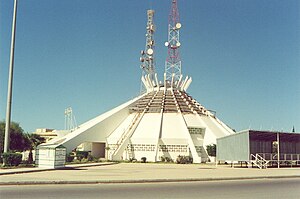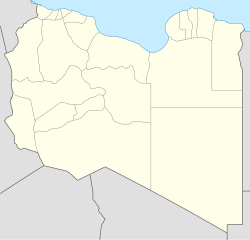
Back Sirte Afrikaans سرت Arabic Sirt Azerbaijani Сірт Byelorussian Сирт Bulgarian Sirte Catalan Sirte CEB Syrta Czech Sirte Welsh Sirte (Libyen) Danish
Sirte
سِرْت | |
|---|---|
 Mathābah al-Madīnah, Assembly building, in Sirte (2007) | |
| Coordinates: 31°12′18″N 16°35′19″E / 31.20500°N 16.58861°E | |
| Country | |
| Region | Tripolitania |
| District | Sirt |
| Elevation | 28 m (92 ft) |
| Population (2013) | |
• Total | 128,123 |
| Time zone | UTC+2 (EET) |
| License Plate Code | 7 |

Sirte (/ˈsɜːrt/; Arabic: سِرْت, ⓘ), also spelled Sirt, Surt, Sert or Syrte, is a city in Libya. It is located south of the Gulf of Sirte, almost right in the middle between Tripoli and Benghazi. It is famously known for its battles, ethnic groups and loyalty to former Libyan ruler Muammar Gaddafi. Due to developments in the First Libyan Civil War, it was briefly the capital of Libya as Tripoli's successor after the Fall of Tripoli from 1 September to 20 October 2011. The settlement was established in the early 20th century by the Italians, at the site of a 19th-century fortress built by the Ottomans. It grew into a city after World War II.
Contrary to popular belief, Sirte was not Muammar Gaddafi's birthplace, as wrongly reported. Gaddafi's birthplace was in a village 20 km south of Sirte, which is called Qasr Abu Hadi. The inhabitants of this village were farmers. Just a few significant people from the Gaddafi tribe, of whom some were born in Sirte, were appointed to government roles during the time of the Libyan Arab Jamahiriya until the NATO-led invasion of Libya in 2011.[1] Sirte was favoured by the Gaddafi government.[2] The city was the final major stronghold of Gaddafi loyalists in the civil war and Gaddafi was killed there by rebel forces on 20 October 2011 after sustaining major injury caused by French Air Force Bombs discharged as part of the NATO intervention. During the battle, Sirte was left almost completely in ruins, with many buildings destroyed or damaged.[3] Six months after the civil war, almost 60,000 inhabitants, more than 70 percent of the pre-war population, had returned.[4]
- ^ "Libya's opposition: Where green refuses to fade". The Economist. 29 June 2013.
- ^ "Should Libya rebuild Gaddafi hometown of Sirte?". BBC News. 9 February 2012. Retrieved 8 September 2021.
- ^ "Sirte, Libya: Gadhafi's hometown seems largely destroyed". The News Tribune. Tacoma, Washington. 16 October 2011. Archived from the original on 24 December 2011.
- ^ Dobbs, L. (16 April 2012). Libya: Displaced Return to Rebuild Gaddafi's Hometown - Face Needs? Archived 17 April 2012 at the Wayback Machine allAfrica. Accessed 22 April 2012
